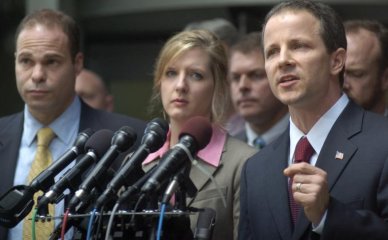
STRATEGY FOR THE ENRON INVESTIGATION
(as suggested by Enron task force prosecutor John Kroger in his book Convictions: A Prosecutor's Battles Against Mafia Killers, Drug Kingpins, and Enron Thieves)
1. Create a special DOJ task force to investigate the Enron case. (This decision, made by Michael Chertoff, the chief of DOJ's criminal division, took the case out of the hands of the U.S. Attorney's Office for the Southern District of Texas, which normally would have had the assignment. According to John Kroger, one of the Enron prosecutors, the decision to appoint a task force was based on the belief that the U.S. Attorney's Office in Houston had a "mediocre" reputation.
2. Chose Leslie Caldwell, an experienced prosecutor with dozens of major gang and white-collar cases on her resume, to head the task force.
3. Staff the investigation mostly with prosecutors who have tried mafia cases, on the theory that they are likely to be aggressive, creative, and have the ability to handle complex cases.
4. Obtain all of Enron's public statements in recent years, including press releases, financial reports, and transcripts of presentations to analysts. Compare whether the public statements painted a picture of the company's financial health that was inconsistent with the facts, as the company executives knew them to be.
5. With only one whistle-blower (Sherron Watkins, a former Enron executive) having stepped forward, look for other high-level Enron executives who had worked with either Fastow or Skilling, and see if they might be willing to talk.
6. Examine complex transactions that might have been designed to doctor financial statements and which could be used as evidence of fraud. Pick and choose the most promising transactions from the approximately 3500 transactions that Enron entered into.
7. Find an Enron "weak link" that might lead to principal architects of a conspiracy. (In the Enron case, an executive named Michael Kopper told investigators that CFO Andy Fastow was the key architect of Enron's illegal manipulations.)
8. To pressure Fastow into entering a guilty plea and cooperating with investigators, indict his wife (even though her alleged criminal behavior normally might not have been enough to bring an indictment), opening up the possibility that his kids would be sent to foster care. [You should ask yourself whether this was ethical.]
9. Use Fastow as the key to building the prosecution case against Jeffrey Skilling and Kenneth Lay.
STRATEGY FOR THE LAY/SKILLING TRIAL
(as suggested by lead trial attorney John Hueston in Behind the Scenes at the Enron Trial)
1. Use CFO Andy Fastow, who had plead guilty, to provide a top-level executive perspective of Lay's and Skilling's knowledge of financial manipulation.
2. Because jurors might have issues with Fastow's credibility (as he admitted to "stealing from the house"), find a witness who can collaborate Fastow's testimony on key points. That witness turned out to be Ben Glisan, the former Treasurer of Enron. Offer him a generous plea agreement, but no deal for his testimony so that he can have maximum credibility with the jury.
3. Open with a witness (Mark Koenig, former Enron head of Investor Relations, who had entered a guilty plea) to explain several of Enron's complex business transactions in simple terms.
4. Take advantage of openings created by the defense, such as the promise of Lay's defense team that the evidence would show "Ken Lay never sold a single share of Enron stock during this period that he was not compelled to sell."
5. Offer the jury in the opening statement a "clear trial narrative." Tell the jury "This is a simple case. It is not about accounting. It is about lies and choices."
6. Find witnesses, such as a pipeline worker who lost his Enron pension and a couple whose retirement savings were reduced to "pennies," who can provide "the human element" and make the trial into "something more than a battle over public disclosure and accounting methods."
7. Try, in the opening statement, to give the jury the sense this is an important an exciting case. (Hueston opened by telling the jury, "Ladies and gentlemen, the United States in this case will take you inside the doors of what was once the seventh largest corporation in this country: Enron." A place where "something was terribly wrong.")
8. Use demonstratives (timelines, etc.) to make dates and other information easier to follow.
9. "Front" Andy Fastow's weaknesses in direct examination to reduce the potentially dramatic effect of having information revealed during cross-examination. Create "traps" on direct than might allow Fastow to bring out information helpful to the prosecution during cross-examination.
10. Call Chrisopher Loehr, who worked with Fastow on his side-deals, to corroborate key portions of his testimony about transactions, such as those listed on the Global Galactic document, designed to disguise Enron's bad financial health.
11. To limit opportunities for confusing cross-examination and damaging impeachment in this long and complex trial, call no more witnesses than necessary. For example, instead of calling members of the Enron Board of Directors, call the Enron corporate secretary, who was present at Board meetings, to describe the reaction of Board members to revelations of Enron's practices. (For example, the reaction of director John Duncan that "Mr. Lay was using Enron like a damn ATM machine.")
12. Focus cross-examination of Skilling and Lay on a few key points where they will be forced to concede lies or deceptive behavior (such as, in Skilling's case, a checkbook revealing backdated checks--or, in Lay's case, that he sold substantially more Enron stock than necessary to meet the margin calls he said was the reason for his sales).
13. In closing argument, show how the trial evidence supports the "lies and choices" narrative suggesting in the opening.
